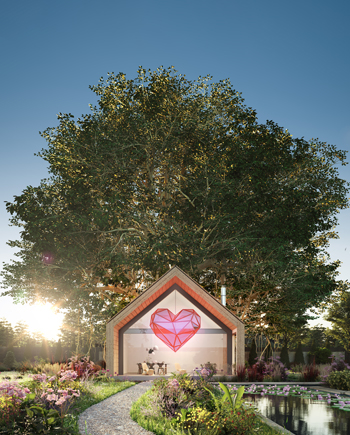What are Houses of Love? During difficult times, it is natural for most of us to seek refuge in the safety and comfort of either our families, our homes, or both. The two are inextricably interwoven but there can be moments when they seem at odds. That’s when you need a plan to step back, assess your life, and rebuild a loving home.
Take moments like this, for example. We live in a time of such genuine political upheaval that many of us in the West don’t have a comparable reference point. Financial crises seem inevitable as international trade relations remain tense and turbulent. And, of course, Covid-19 and other global health fears have had us literally locking our doors. Most mothers amongst us have had to quarantine at home with our families.
It is in times like these that our most valuable relationships are put to the test. Or, at least, that has been my personal experience and that of my closest friends. Whatever issues we were running away from before, whether consciously or unconsciously, or hidden by our working lives, we have been confronted by all of them by staying at home.
Family dynamics can sometimes be tense or complicated – especially during difficult situations
Every mother will recognize the truth of that statement (if she’s being honest with herself, at least!). Whatever the family setup, mothers will always take a special responsibility upon themselves to be the glue that holds a family together. Personal concerns are often put on the back-burner so that she can act as the peacemaker. Our nurturing instincts take over whenever chaos threatens the nest.
That can be a stressful role even at the best of times. But add a measure of cabin fever and a daily dose of real world fears to that mixture and it can border on toxicity. For those of us who really value and draw strength from our closest relationships, the subsequent lack of any sanctuary – a safe space to feel comfortable with one’s family – can be almost as damaging mentally as any virus is physically.
Clearing the air: Improving a family dynamic is a lot like renovating your home
If you’re reading this, the chances are that you still live in a loving home. That’s something that we should never forget, or take for granted. But every home needs the occasional spring cleaning. And the same is true for the relationships within our home. They need just as much maintenance – if not more – than your average 3 bedroom in the ‘burbs.
Metaphors aside: you shouldn’t think that the problems you’re currently facing mean that you can’t improve your familial relationships in future. You can always improve your family in much the same way you can improve your house. It just takes a lot of hard, daily work.
What makes family homes ‘Houses of Love’?
I have had the honor of designing and building beautiful homes for tens of dozens of families. I have sat for hours in meetings with clients while they tell me their dreams and visions for their perfect home. How the design needs to fit their present lifestyle and future growth. As a young professional, I used to think that my designs alone would bring happiness and healing to the families I worked with. But, as time went by, I realized that a house, as beautiful as it may be, could not necessarily fix the relationships of its inhabitants.
I learned that physically beautiful homes were not necessarily loving homes. They were not Houses of Love.
My biggest accomplishment is to have built my own House of Love. After a painful divorce, with enough soul searching and God’s help, I was able to rebuild my life and that of my children and create a home filled with peace, joy and beauty.
How to design, build and maintain ‘Houses of Love’
Just like any building, Houses of Love need to be thoughtfully planned, beautifully designed and skillfully built. Its foundations need to support everything it stands for. Those foundations are the timeless Judeo-Christian core values derived from the Ten Commandments and Jesus’ message of “Love God above all, and love others as yourself”.
Because that love is divine, you can start building a House of Love at any time. No matter what has happened in your past.
In my case, I used the same methods I employ for building an actual house to create my own House of Love. I’m sharing them here in the hope that they might be useful to you too:
Three steps to building and maintaining ‘Houses of Love’
Every time I decide to build or renovate a house, I follow a three step process:
Step 1: Make a decision – and stick to it!
The first step is to make the decision. Say it out loud to make it concrete – a promise you make to yourself and to God: “Starting today, I will improve my relationships within my family”.
It may be hard to accept at first, but it is often with our families that we most need to improve our communication. So often, when interacting with our loved ones, we allow things to go unspoken. We cut corners on the little things because we know we’ll be forgiven. We take people for granted. Making that decision is a chance for you – and those who look to you for guidance – to strengthen your core values.
Step 2: Assess what needs to be removed and what has to stay
Any professional designer will tell you that you need blueprints – a plan. But there is a step before that. You need to have a vision, a dream. Give yourself permission to imagine what it means for you to have a perfect family. Have the courage to dream about it.
What does a perfect home mean to you? Focus on its spiritual qualities, the emotions, the feelings. Not the physical aspects of it. Just remember: what is unseen is eternal (2 Corinthians 4:18).
Before you draw up your plans, there are always two key decisions that need to be made:
Which elements are important and worth keeping?
Which are damaging and need to be discarded?
Those are questions that only you can answer. Laying new or restored foundations for a family is no easy task. The goal is to build an unbreakable structure with the strongest of bonds between family members. If resentments have been harbored, and communication has been broken, the challenge is not to plaster over those cracks. You have to address the underlying structural defects – and commit to repairing them.
Step 3: Draw up your plans, then implement them
The strongest designs start in your heart and in your mind. Do this planning when you are alone at home or in a private space.
My advice – and what worked for me – is to start by softening your heart with forgiveness. Be humble in front of yourself! It’s crucial to recognize that none of us are perfect. Honesty is key. My thoughts crystallized during this process as follows: “I am not a perfect woman and I have acted in ways that are imperfect, as all humans have.”
It is all-too-common for many of us to start by blaming others. “If only they had checked the planning permits beforehand,” you might think, or “if only they had listened to me from the start!” But that isn’t a mature way to live – and it doesn’t help to design your new, loving home. Once we see ourselves in a mirror of honesty, we can move forward and forgive the ones who live with us. They are not perfect either.
What goals should I have in mind when designing my House of Love?
Why is it so important to fix and improve our physical homes? Because it provides a better quality of life for everyone who lives there. Houses of Love should reflect the very same principle.
Once you’re in the right frame of mind to start designing, think about the basics first. The goal of good design is always to improve flow of the floorplan – to make the connections between rooms easy and practical. The same rules apply to our families. The primary goal should always be to improve communications with our spouse and kids.
Other design aims include giving the house more clearly defined spaces, as well as a logical hierarchy. To improve the quality of its materials, to fix what needs to be fixed – all while making it more harmonious.
Again, the same is true for our families.
Conclusion: how to realize your vision of a perfect, loving home
Once you’ve defined your vision, you’ll need a literal plan. This is the point where real world changes can be made that will – if you’ve followed the steps above – help turn your home into a House of Love.
Take a pen and a paper and start going room by room. Think of your living room: what goes on there daily? What kind of interactions would you like there? For example: “I would like a lot of conversation here.” Then move into the kitchen, and write what you’d like to see there. Perhaps, “I would like a home with no stress – even during meals!” Go into the master bedroom. Perhaps here you envision a place of marital harmony and no strife.
That type of structured thinking can help shape the physical spaces you inhabit (I cover that in another post here). That in turn can help you improve your relationships, inspire positivity and ensure that your home is a place of sanctuary during troubling times – a true House of Love.
Gabriela Liebert



